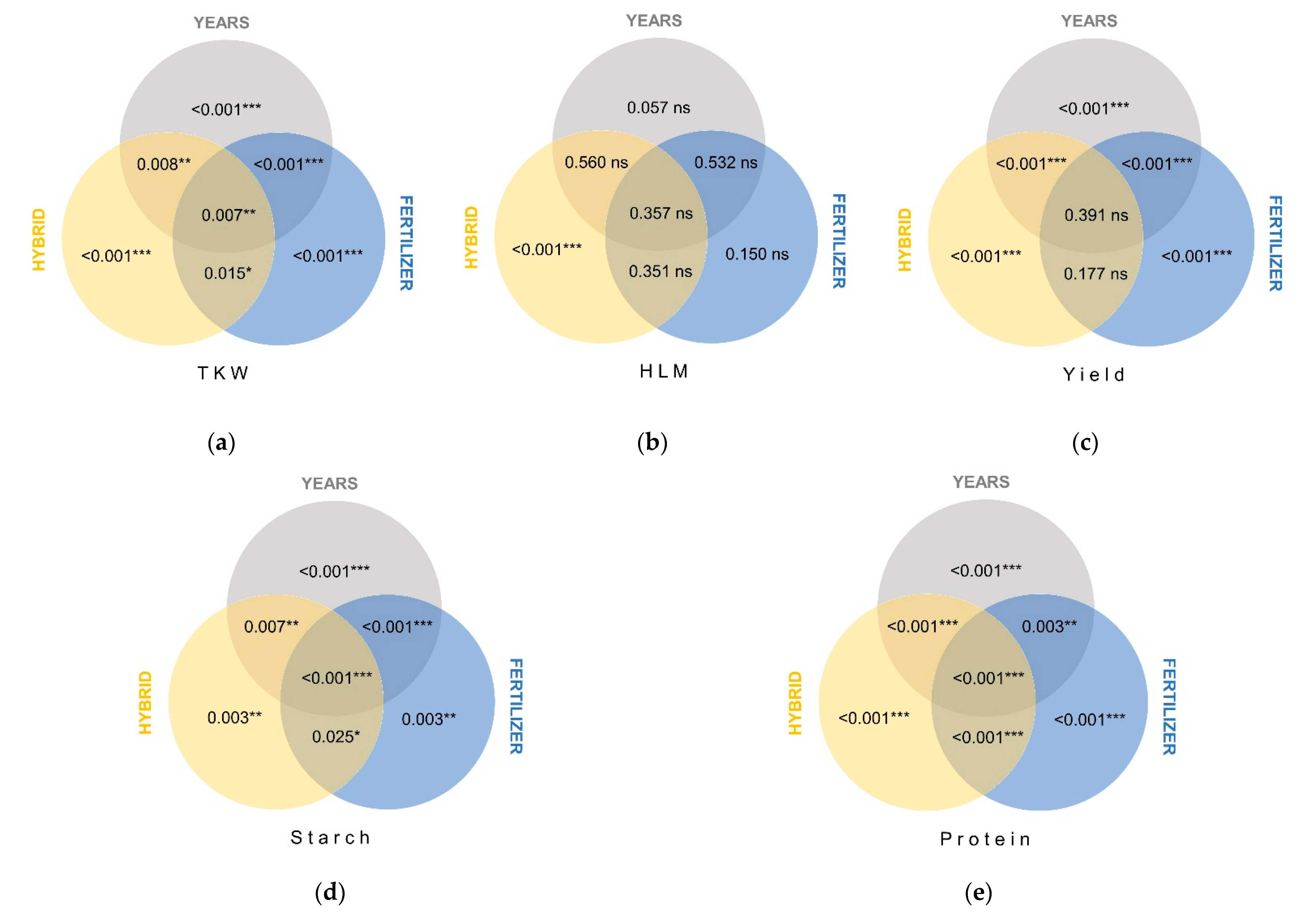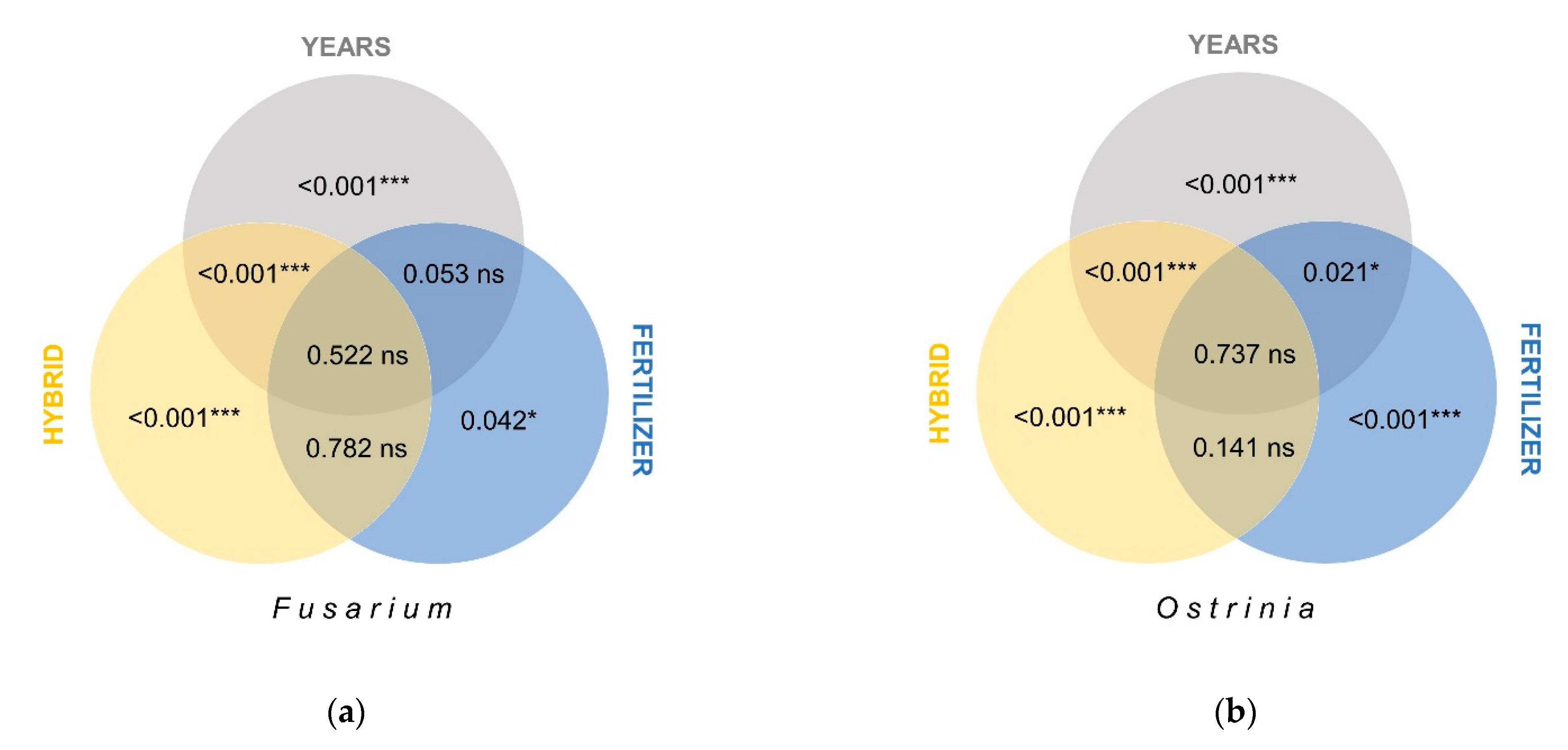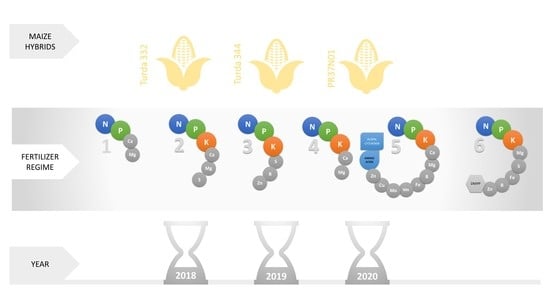Evaluation of Agronomic Performance of Maize (Zea mays L.) under a Fertilization Gradient in Transylvanian Plain
Abstract
:1. Introduction
2. Materials and Methods
2.1. Location and Pedo-Climatic Conditions
2.2. Organization of the Experiment
- Factor Y (the experimental years) with three levels:
- ○
- Y1—2018;
- ○
- Y2—2019;
- ○
- Y3—2020.
- Factor H (the hybrid) with three levels:
- ○
- H1—Turda 332;
- ○
- H2—Turda 344;
- ○
- H3—PR37N01.
- Factor F (fertilization) with six levels:
- ○
- F1—Basal + CAN (Calcium ammonium nitrate) = (N67.5P33.75) + (N54);
- ○
- F2—Eurofertil Top 51 NPK + CAN = (N10P25K50S42.5Mg5) + (N54);
- ○
- F3—Basal + Synertec NK35 N-process = (N67.5P33.75) + (N50K20S42Zn0.4B0.4);
- ○
- F4—Basal + CAN + Fertiactyl Starter = (N67.5P33.75) + (N54) + Biostimulator;
- ○
- F5—Basal + CAN + Rootip Basic + Energevo = (N67.5P33.75) + (N54) + Rooting Biostimulator + Foliar fertilizer with microelements;
- ○
- F6—NovaTec Classic = N24P16K32Mg6S18 and microelements.
- “Turda 332” has good resistance to drought and shriveling of kernels. Plants are tall with 16–17 leaves. The ear is long with a cylindrical shape, having 18–22 rows and red rachis. Kernels are dentate with a dark yellow color. Thousand kernels weight is between 220 and 240 g [24].
- “Turda 344” is characterized by high productivity potential of 14 t/ha, good resistance to low temperatures during first growth stages. Plants are tall, reaching 3.30 m in height, and ear insertion is between 1.20 and 1.30 m. It is stay-green hybrid. The ear has 18–29 rows and thousand kernels weight of 300–320 g. Kernels are dentate [24].
- “PR37N01” is a hybrid with stable yields and resistant to drought, lodging and main maize crop pests and diseases. It has balanced height and medium–high ear insertion. The ear has 16–18 rows and 37–41 kernels per row. It is a stay-green maize hybrid [26].
2.3. Determinations
- -
- plant characteristics: plant height (m), ear insertion height (m), leaf length (m), leaf width (cm), leaves number above ear.
- -
- quantitative productivity parameters: thousand kernels weight (TKW g), hectoliter mass (HLM kg/hl), yield (kg/ha).
- -
- qualitative parameters of maize grains: starch content (%), protein content (%).
- -
- disease and pest’s incidence on maize ears: Fusarium sp. and Ostrinia nubilalis frequency (%).
2.4. Statistical Analysis
3. Results
3.1. Characteristics of Plants
3.2. Quantitative and Qualitative Productivity Components of Maize
3.3. Disease and Pest Incidence
4. Discussion
5. Conclusions
Supplementary Materials
Author Contributions
Funding
Institutional Review Board Statement
Informed Consent Statement
Data Availability Statement
Conflicts of Interest
References
- FAOSTAT. Available online: http://www.fao.org/faostat/en/#rankings/countries_by_commodity (accessed on 18 August 2021).
- Statistics|Eurostat. Available online: https://ec.europa.eu/eurostat/databrowser/view/tag00093/default/table?lang=en (accessed on 18 August 2021).
- Porumb—Ministerul Agriculturii si Dezvoltarii Rurale. Available online: https://www.madr.ro/culturi-de-camp/cereale/porumb.html (accessed on 18 August 2021).
- Cheverdin, A.; Piskareva, L. Influence of mineral fertilizers and growth regulators for maize yield. J. Agric. Environ. 2020, 1–4. [Google Scholar] [CrossRef]
- Adhikary, B.H.; Baral, B.R.; Shrestha, J. Productivity of winter maize as affected by varieties and fertilizer levels. Int. J. Appl. Biol. 2020, 4, 85–93. [Google Scholar] [CrossRef]
- Nafziger, E.; Rapp, D. Corn yield response to late-split nitrogen fertilizer. Agron. J. 2021, 113, 527–536. [Google Scholar] [CrossRef]
- Tenorio, F.A.M.; McLellan, E.L.; Eagle, A.J.; Cassman, K.G.; Andersen, D.; Krausnick, M.; Oaklund, R.; Thorburn, J.; Grassini, P. Benchmarking impact of nitrogen inputs on grain yield and environmental performance of producer fields in the western US Corn Belt. Agric. Ecosyst. Environ. 2020, 294, 106865. [Google Scholar] [CrossRef]
- Ray, K.; Banerjee, H.; Dutta, S.; Sarkar, S.; Murrell, T.S.; Singh, V.K.; Majumdar, K. Macronutrient Management Effects on Nutrient Accumulation, Partitioning, Remobilization, and Yield of Hybrid Maize Cultivars. Front. Plant Sci. 2020, 11, 1307. [Google Scholar] [CrossRef] [PubMed]
- Ibrahim, K.; Wang, Q.; Wang, L.; Zhang, W.; Peng, C.; Zhang, S. Determining the Optimum Level of Soil Olsen Phosphorus and Phosphorus Fertilizer Application for High Phosphorus-Use Efficiency in Zea mays L. in Black Soil. Sustainability 2021, 13, 5983. [Google Scholar] [CrossRef]
- Woli, K.P.; Sawyer, J.E.; Boyer, M.J.; Abendroth, L.J.; Elmore, R.W. Corn Era Hybrid Macronutrient and Dry Matter Accumulation in Plant Components. Agron. J. 2018, 110, 1648–1658. [Google Scholar] [CrossRef] [Green Version]
- Ciampitti, I.A.; Vyn, T.J. Maize Nutrient Accumulation and Partitioning in Response to Plant Density and Nitrogen Rate: II. Calcium, Magnesium, and Micronutrients. Agron. J. 2013, 105, 1645–1657. [Google Scholar] [CrossRef]
- Brankov, M.; Simić, M.; Dolijanović, Ž.; Rajković, M.; Mandić, V.; Dragičević, V. The Response of Maize Lines to Foliar Fertilizing. Agriculture 2020, 10, 365. [Google Scholar] [CrossRef]
- Reyes Gaige, A.; Rowe, B.; Jurin, V. Assessment of Efficiency of Nutrient Uptake of Different Sources of Zn, Mn, Cu and B in Zea mays. Agriculture 2020, 10, 247. [Google Scholar] [CrossRef]
- Moraru, P.I.; Rusu, T.; Bogdan, I.; Pop, A.; Coste, C.; Duda, B.; Sälägean, T.; Șopterean, M.; Ivan, I. The Influence of Slope Morphology upon the Thermic Regime of Soil andManagement Practices in the Transylvanian Plain. Bull. Univ. Agric. Sci. Vet. Med. Cluj-Napoca Agric. 2014, 71, 256–263. [Google Scholar] [CrossRef] [Green Version]
- Embleton, C. Geomorphology of Europe; Macmillan International Higher Education: London, UK, 2016; ISBN 978-1-349-17346-4. [Google Scholar]
- Bunescu, V.; Mihai, G.; Bunescu, H.; Man, I. Ecological Conditions and Soils from Transylvanian Plateau; Academic Press: Cluj-Napoca, Romania, 2005. [Google Scholar]
- Malschi, D. Environment-Agriculture-Sustainable Development and Integrated Pest Management of Cereal Agroecosystems; Argonaut: Cluj-Napoca, Romania, 2007; ISBN 978-973-109-086-3. [Google Scholar]
- Grecu, I.; Haș, I.; Nagy, C. The 50th Anniversary 1957–2007 (ARDS Turda)—Results Obtained in the Reserach-Development Activity; Ela Design: Turda, Romania, 2007; ISBN 978-973-0-05311-1. [Google Scholar]
- Romania Climate: Köppen-Geiger Climate Classification for Turda. Available online: https://en.climate-data.org/europe/romania-185/ (accessed on 9 September 2021).
- Chețan, F.; Rusu, T.; Chețan, C.; Moraru, P.I. Influence of soil tillage upon weeds, production and economical efficiency of corn crop. AgroLife Sci. J. 2016, 5, 36–43. [Google Scholar]
- Naturevo—îngrășăminte, Semințe, Fertilizanți Foliari. Available online: https://www.naturevo.ro/ (accessed on 7 August 2021).
- Soluțiile Noastre—Nutritia Plantelor. Available online: https://ro.timacagro.com/categorie-produit/solutiile-noastre/?nutrition=2&aff=1 (accessed on 17 August 2021).
- Meier, U. BBCH Monograph—Growth Stages of Mono- and Dicotyledonous Plants; Julius Kühn-Institut (JKI): Quedlinburg, Germany, 2018; ISBN 978-3-95547-071-5. [Google Scholar] [CrossRef]
- Soiuri, Hibrizi—Statiunea de Cercetare Dezvoltare Agricola Turda. Available online: https://scdaturda.ro/soiurihibrizi/ (accessed on 7 August 2021).
- Corn Seeds—Pioneer. Available online: https://www.pioneer.com/us/search.html (accessed on 7 August 2021).
- Seminte de Porumb Pioneer PR37N01. Available online: https://www.agronor.ro/seminte-de-porumb-pioneer-pr37n0125000-seminte (accessed on 10 September 2021).
- Granomat: Umidimetru Pentru Boabe întregi—Pfeuffer GmbH (Quality Control of Grain and Seeds). Available online: https://www.pfeuffer.com/ro/produs/granomat (accessed on 7 August 2021).
- TANGO FT-NIR Spectrometer. Available online: https://www.bruker.com/en/products-and-solutions/infrared-and-raman/ft-nir-spectrometers/tango-ft-nir-spectrometer.html (accessed on 7 August 2021).
- ISTIS Metodica. Available online: https://istis.ro/image/data/download/publicatii/MetodicaVAU.pdf (accessed on 7 August 2021).
- OriginLab—Origin and OriginPro—Data Analysis and Graphing Software. Available online: https://www.originlab.com/ (accessed on 9 September 2021).
- Njoroge, R.; Otinga, A.N.; Okalebo, J.R.; Pepela, M.; Merckx, R. Maize (Zea mays L.) Response to Secondary and Micronutrients for Profitable N, P and K Fertilizer Use in Poorly Responsive Soils. Agronomy 2018, 8, 49. [Google Scholar] [CrossRef] [Green Version]
- Silva, C.G.M.; de Resende, Á.V.; Gutiérrez, A.M.; Moreira, S.G.; Borghi, E.; Almeida, G.O. Macronutrient uptake and export in transgenic corn under two levels of fertilization. Pesqui. Agropecu. Bras. 2018, 53, 1363–1372. [Google Scholar] [CrossRef]
- Borase, C.L.; Lomte, D.M.; Thorat, S.D.; Dhonde, A.S. Response of Kharif maize (Zea mays L.) to micronutrients. J. Pharmacogn. Phytochem. 2018, 7, 482–484. [Google Scholar]
- Mahmood, Y.A.; Ahmed, F.W.; Mohammed, I.Q.; Wheib, K.A. Effect of Organic, Mineral Fertilizers and Foliar Application of Humic Acid on Growth and Yield of Corn (Zea mays L.). Indian J. Ecol. 2020, 47, 39–44. [Google Scholar]
- Al-Budeiri, M.H.; Al-Shami, Y.A.O. Effect of addition mineral, organic and bio-fertilizers on nitrogen, phosphorous, potassium concentration and protein of corn crop (Zea mays L.). IOP Conf. Ser. Earth Environ. Sci. 2021, 735, 012062. [Google Scholar] [CrossRef]
- Kapela, K.; Sikorska, A.; Niewęgłowski, M.; Krasnodębska, E.; Zarzecka, K.; Gugała, M. The Impact of Nitrogen Fertilization and the Use of Biostimulants on the Yield of Two Maize Varieties (Zea mays L.) Cultivated for Grain. Agronomy 2020, 10, 1408. [Google Scholar] [CrossRef]
- Razhan, B.M.; Ghafoor, A.M.R. Influence of Foliar Application of some Micronutrients on Maize Kernel Yield and Nutrient content. J. Zankoy Sulaimani 2020, 22, 77–88. [Google Scholar]
- Stewart, Z.P.; Paparozzi, E.T.; Wortmann, C.S.; Jha, P.K.; Shapiro, C.A. Effect of Foliar Micronutrients (B, Mn, Fe, Zn) on Maize Grain Yield, Micronutrient Recovery, Uptake, and Partitioning. Plants 2021, 10, 528. [Google Scholar] [CrossRef]
- Ghețe, A.B.; Haș, V.; Vidican, R.; Copândean, A.; Ranta, O.; Moldovan, C.M.; Crișan, I.; Duda, M.M. Influence of Detasseling Methods on Seed Yield of Some Parent Inbred Lines of Turda Maize Hybrids. Agronomy 2020, 10, 729. [Google Scholar] [CrossRef]
- Wyszkowski, M.; Brodowska, M.S. Potassium and Nitrogen Fertilization vs. Trace Element Content of Maize (Zea mays L.). Agriculture 2021, 11, 96. [Google Scholar] [CrossRef]
- Szulc, P.; Ambroży-Deręgowska, K.; Waligóra, H.; Mejza, I.; Grześ, S.; Zielewicz, W.; Wróbel, B. Dry Matter Yield of Maize (Zea mays L.) as an Indicator of Mineral Fertilizer Efficiency. Plants 2021, 10, 535. [Google Scholar] [CrossRef]
- Szulc, P.; Bocianowski, J.; Nowosad, K.; Bujak, H.; Zielewicz, W.; Stachowiak, B. Effects of NP Fertilizer Placement Depth by Year Interaction on the Number of Maize (Zea mays L.) Plants after Emergence Using the Additive Main Effects and Multiplicative Interaction Model. Agronomy 2021, 11, 1543. [Google Scholar] [CrossRef]
- Medina-Cuéllar, S.E.; Tirado-González, D.N.; Portillo-Vázquez, M.; Orozco-Cirilo, S.; López-Santiago, M.A.; Vargas-Canales, J.M.; Medina-Flores, C.A.; Salem, A.Z.M. Optimal Nitrogen Fertilization to Reach the Maximum Grain and Stover Yields of Maize (Zea mays L.): Tendency Modeling. Agronomy 2021, 11, 1354. [Google Scholar] [CrossRef]
- Ray, K.; Banerjee, H.; Dutta, S.; Hazra, A.K.; Majumdar, K. Macronutrients influence yield and oil quality of hybrid maize (Zea mays L.). PLoS ONE 2019, 14, e0216939. [Google Scholar] [CrossRef] [PubMed] [Green Version]





| Fertilizer | Contents 1 | Chemical Composition 1 | Application/ BBCH Stage [23] | Dose Used |
|---|---|---|---|---|
| Basal complex | NP 27:13.5 | 27% N; 13.5% P | at sowing (stage 00–01) | 250 kg/ha |
| Eurofertil Top 51 NPK | NPK + other elements (Ca, Mg, S, B, Zn) | 4% NH4; 27.2% P2O5; 20% K2O; 2% MgO; 17 % SO3; 12% CaO, 0.2% B; 0.15% Zn | at sowing (stage 00–01) | 250 kg/ha |
| NovaTec Classic | NPK 12:8:16 + other elements (Mg, S, B, Fe, Zn) + nitrifying inhibitors | 12% N (5.0% NO3 + 7.0% NH4); 8.0% P2O5; 16.0% K2O; 3.0% MgO; 10% SO3; 0.02% B; 0.06% Fe; 0.01% Zn; 0.056% DMPP (3,4-dimethylpyrazole phosphate) | at sowing (stage 00–01) | 200 kg/ha |
| CAN | Calcium ammonium nitrate: N + other elements (Ca, Mg) | 27% N; 7% CaO; 5% MgO | 4–8 leaves (stage 14–18) | 200 kg/ha |
| Synertec NK35 N-process | NK + other elements (S, B, Zn) | 25% N; 10% K2O; 21% SO3; 0.2% Zn; 0.2% B | 4–8 leaves (stage 14–18) | 200 kg/ha |
| Energevo | NPK 9:53:9 + other elements (Mg, B, Fe, Mn, Mo, Cu, Zn) | 9% N; 53% P2O5; 9% K2O; 1% S; 2.5% MgO; 0.1% B; 0.1% Fe; 0.05% Mn; 0.1% Zn; 0.05% Cu; 0.005% Mo. | 4–8 leaves (stage 14–18) | 3 kg/ha |
| Fertiactyl Starter | NPK 13:5:8 | 13% CO(NH2)2; 5% P2O5; 8% K2O | 4–8 leaves (stage 14–18) | 3 L/ha |
| Rootip Basic | NK + amino acids + phytohormone precursors (of auxin, cytokinin) | 9% N (3.9% NO3, 3.9% NH4, 1.2% organic nitrogen); 1.7% K2O; 7.8% amino acids; 7% organic matter | 4–8 leaves (stage 14–18) | 1.5 L/ha |
| Year | Hybrid | Plant Height (m) | Ear Insertion (m) | Leaf Length (m) | Leaves Number |
|---|---|---|---|---|---|
| 2018 | Turda 332 | 2.28 a | 1.10 bc | 0.83 a | 5.31 a |
| Turda 344 | 2.49 bc | 1.24 c | 0.87 b | 5.46 a | |
| PR37N01 | 2.38 ab | 1.14 bc | 0.84 a | 5.40 a | |
| 2019 | Turda 332 | 2.63 cd | 1.01 ab | 0.87 b | 6.08 b |
| Turda 344 | 2.73 d | 1.13 bc | 0.84 a | 5.90 b | |
| PR37N01 | 2.63 cd | 0.99 ab | 0.84 a | 5.84 b | |
| 2020 | Turda 332 | 2.81 d | 1.15 bc | 0.96 d | 5.40 a |
| Turda 344 | 2.76 d | 1.06 ab | 0.95 d | 5.42 a | |
| PR37N01 | 2.62 cd | 0. 92 a | 0.90 c | 6.00 b |
| Year | Fertilization Regime | TKG (g) | Yield (kg/ha) | Starch (%) | Protein (%) |
|---|---|---|---|---|---|
| 2018 | Basal + CAN | 326.78 Ct. | 9897.67 Ct. | 72.49 Ct. | 7.24 Ct. |
| Eurofertil Top 51 NPK + CAN | 341.67 | 11,066.33 *** | 78.08 *** | 7.38 | |
| Basal + Synertec NK35 N-process | 331.89 | 10,764.11 ** | 72.71 | 7.69 * | |
| Basal + CAN + Fertiactyl Starter | 330.89 | 10,843.22 ** | 72.81 | 7.32 | |
| Basal + CAN + Rootip Basic + Energevo | 305.22 * | 11,935.11 *** | 73.27 | 7.68 * | |
| NovaTec Classic | 288.33 * | 11,280.78 *** | 73.25 | 6.77 * | |
| 2019 | Basal + CAN | 244.56 Ct. | 7528.00 Ct. | 60.55 Ct. | 8.24 Ct. |
| Eurofertil Top 51 NPK + CAN | 259.00 | 7650.89 | 60.49 | 8.71 ** | |
| Basal + Synertec NK35 N-process | 252.22 | 7456.56 | 60.05 | 8.69 * | |
| Basal + CAN + Fertiactyl Starter | 252.22 | 7443.11 | 59.88 | 8.32 | |
| Basal + CAN + Rootip Basic + Energevo | 263.00 * | 7499.33 | 61.94 | 8.66 * | |
| NovaTec Classic | 253.67 | 7315.78 | 61.89 | 7.75 * | |
| 2020 | Basal + CAN | 300.00 Ct. | 11,667.44 Ct. | 73.08 Ct. | 7.02 Ct. |
| Eurofertil Top 51 NPK + CAN | 317.78 * | 12,558.00 ** | 74.08 | 6.77 | |
| Basal + Synertec NK35 N-process | 306.67 | 13,420.33 *** | 76.48 ** | 6.56 * | |
| Basal + CAN + Fertiactyl Starter | 300.00 | 12,523.22 ** | 73.59 | 7.22 | |
| Basal + CAN + Rootip Basic + Energevo | 317.78 * | 12,020.00 | 72.66 | 7.12 | |
| NovaTec Classic | 302.22 | 12,405.89 * | 75.95 * | 6.43 * | |
| LSD p 5% | 16.81 | 576.96 | 2.22 | 0.35 | |
| LSD p 1% | 22.21 | 762.51 | 2.93 | 0.46 | |
| LSD p 0.1% | 28.72 | 985.76 | 3.79 | 0.59 | |
| Hybrid | Year | Fusarium sp. (%) | Ostrinia nubilalis (%) |
|---|---|---|---|
| Turda 332 | Average (Ct.) | 50.46 | 47.80 |
| 2018 | 75.11 *** | 64.89 *** | |
| 2019 | 40.28 | 56.56 ** | |
| 2020 | 36.00 * | 21.94 * | |
| Turda 344 | Average (Ct.) | 30.04 | 36.80 |
| 2018 | 53.78 ** | 49.33 *** | |
| 2019 | 20.06 | 42.67 * | |
| 2020 | 16.28 * | 18.39 * | |
| PR37N01 | Average (Ct.) | 20.37 | 26.54 |
| 2018 | 29.78 | 31.11 | |
| 2019 | 12.56 | 27.22 | |
| 2020 | 18.78 | 21.28 * | |
| LSD p 5% | 10.51 | 4.71 | |
| LSD p 1% | 15.49 | 6.89 | |
| LSD p 0.1% | 24.12 | 10.54 | |
| Fertilization Regime | Fusarium sp. (%) | Ostrinia nubilalis (%) |
|---|---|---|
| Basal + CAN | 31.96 Ct. | 40.93 Ct. |
| Eurofertil Top 51 NPK + CAN | 32.56 | 39.52 |
| Basal + Synertec NK35 N-process | 37.19 | 41.3 |
| Basal + CAN + Fertiactyl Starter | 38.74 * | 36.33 |
| Basal + CAN + Rootip Basic + Energevo | 28.78 | 25.7 *** |
| NovaTec Classic | 32.52 | 38.48 |
| LSD p 5% | 6.18 | 5.16 |
| LSD p 1% | 8.16 | 6.82 |
| LSD p 0.1% | 10.55 | 8.81 |
Publisher’s Note: MDPI stays neutral with regard to jurisdictional claims in published maps and institutional affiliations. |
© 2021 by the authors. Licensee MDPI, Basel, Switzerland. This article is an open access article distributed under the terms and conditions of the Creative Commons Attribution (CC BY) license (https://creativecommons.org/licenses/by/4.0/).
Share and Cite
Barșon, G.; Șopterean, L.; Suciu, L.A.; Crișan, I.; Duda, M.M. Evaluation of Agronomic Performance of Maize (Zea mays L.) under a Fertilization Gradient in Transylvanian Plain. Agriculture 2021, 11, 896. https://doi.org/10.3390/agriculture11090896
Barșon G, Șopterean L, Suciu LA, Crișan I, Duda MM. Evaluation of Agronomic Performance of Maize (Zea mays L.) under a Fertilization Gradient in Transylvanian Plain. Agriculture. 2021; 11(9):896. https://doi.org/10.3390/agriculture11090896
Chicago/Turabian StyleBarșon, Gabriel, Laura Șopterean, Loredana Alexandra Suciu, Ioana Crișan, and Marcel Matei Duda. 2021. "Evaluation of Agronomic Performance of Maize (Zea mays L.) under a Fertilization Gradient in Transylvanian Plain" Agriculture 11, no. 9: 896. https://doi.org/10.3390/agriculture11090896
APA StyleBarșon, G., Șopterean, L., Suciu, L. A., Crișan, I., & Duda, M. M. (2021). Evaluation of Agronomic Performance of Maize (Zea mays L.) under a Fertilization Gradient in Transylvanian Plain. Agriculture, 11(9), 896. https://doi.org/10.3390/agriculture11090896






